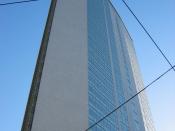Pier Luigi Nervi
Master Builder
This man was described as "quiet and grey" but with his stern doctrine of integrity, truth, and correctness in building structures he brought technological innovation and esthetical triumph to the landscape of Italy during a forty-year period that spanned from Fascism through the economic boom years.
Nervi was born in 1891, in the last decade of the nineteenth century in the Italian Alps town of Sondrio, Lombardy. He attended the University of Bologna and joined the army engineering corps following the entanglement of Italy in World War One. After the war was over, he joined a group called "The Society for Concrete Construction." It was not until after he left the group in 1923 that his unique approach to building gained significant attention. Nervi had never remained satisfied with a new concept or method, and he never stopped exploring, testing, and working out new kinds of structures and new methods for building them.
One of the Nervi's accomplishments is the invention of Ferro-Cemento, a reinforced concrete of entirely new concept, which combines concretes' freedom of form with steel's qualities of strength. It is a "super" reinforced concrete, ideally suited to the realization of large structures. It was the answer to the two fundamental economic questions of reinforced concrete: how to reduce the cost of forms, and how to manufacture a concrete structure by mass-production methods. Some of Nervi's most exciting structures owe their existence to Ferro-Cemento. Nervi built the first large prefabricated thin shells, which to this day remain unsurpassed as examples of architectural imagination and structural design. Making forms out of Ferro-Cemento, Nervi revolutionized flat-slab design and introduced the application of mass-production methods to the erection of large concrete buildings for industrial purposes. Nervi had put this material to use in building some of...
![[The coast, Nervi, Genoa, Italy] (LOC)](https://s.writework.com/uploads/5/52726/coast-nervi-genoa-italy-loc-thumb.jpg)
![[General view, Nervi, Genoa, Italy] (LOC)](https://s.writework.com/uploads/5/52726/general-view-nervi-genoa-italy-loc-thumb.jpg)
